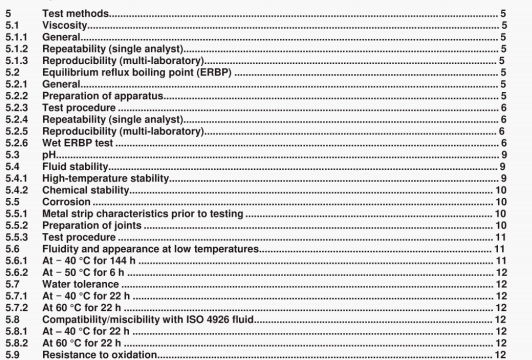BS ISO 04925 pdf download – Road vehicles——Specification ofnon-petroleum-basebrake fluids for hydraulic systems.
5.2.3 Test procedure
Turn on the condenser water and apply heat to the flask at such a rate that the fluid Is reffuxing within (10 ± 2) mm at a rate higher than one drop per second. The reflux rate shaH not exceed five drops per second Immediately Øust the heat input to obtain a specified equilibnum reflux rate of one drop per second to two drops per second over the next (5 ± 2) mm period. Maintain a timed and constant equitibnum ref tux rate of one drop per second to two drops per second for an additional 2 mm; record the average value of tour temperature readings taken at 30 s intervals at the equiIibrum reftux boiling po4nt.
Report the boiling point to the nearest degree Celsius. Duplicate results that agree within 3 C are acceptable for averages (95 % confidence level).
5.2.4 Repeatability (single analyst)
The standard deviation of results (each the average of duplicates), obtained by the same analyst on different days shall not be greater than 1,3 C at 34 degrees of freedom Two such values shall be considered unacceptable (95% confidence level) if they differ by more than 4 C.
5,2.5 Reproducibility (multi-laboratory)
The standaj-d devialjon of results (each the average of duplicates), obtained by analysts in different laboratories, shall be not greater than 3.5 C at 15 degrees of freedom. Two such values shal be considered unacceptable (95 % confidence level) it they differ by more than 10.5 °C.
5.2.6 Wet ERBPtest
5.2.6.1 Apparatus
5.2.6.1.1 Two corrosion test jars or equivalent saew-top, straight-sided. round glass jars each having a capacity of about 475 ml and approximate inner dimensions of 100 mm height by 75 mm diameter, with matching lids having new, clean insects providing waterpmooI and vapourproof seals
5.2.6.1.2 Desiccator and cover: bowt-form glass desiccator with 250 mm inside diameter, having a matching tubulated cover titled with a No. 8 rubber Stopper (see Figure 3).
5.2.6.1.3 Desiccator plate of 230 mm diameter, perforated porcelain desiccator plate, without feet, glazed on one side (No.18 or equivalent).
5.5 Corrosion
5.5.1 Metal strip characteristics prior to testing
Prepare tw9 sets of strips from each of the metals listed in Table 1, each str having a surface area of (25 ± 5) cm (approximately 8 cm long, 1,3cm wide, and not more than 0,6 cm thick). Drill a hole 01 between 4 mm and 5 mm in diameter and about 6 mm from one end of each strip With the exception of me tinned iron strips, clean the strips by abrading them on al surface areas with 320A or P400 waterproof carborundum paper and ethanol (laboratory grade) until al surface scratches, cuts and pits are removed from the strips. using a new piece of carborundum paper for each different type of metaJ. Wash the strips, including the tinned iron, with ethanol (laboratory grade), then dry them w’itti a clean lint-free cloth and place them in a desiccator containing desiccant maintained at (23 ± 5) C for at least 1 h. Handle the strips witti clean forceps after polishing to avoid fingerprint contamination.
Determine the mass of each strip to the nearest 0.1 mg fld assemble eacn set of strips on an uncoated steel cotter pin or boil in the followpg order, so that the strips are in electrical contact: tinned won, steel, aluminium, cast iron, brass and copper Bend the strips, except for the cast iron, so that there is a separation of approximately 10mm between two adpacent strips at their free ends Immerse the strip assemblies in ethanol (laboralory grade) to eliminate fingerprints (see Annex C).
5.5.2 Preparation of joints
Measure the base diameter of two standard SBR cups (see Annex A). using an optical comparator or micrometer, to the nearest 0,02 mm. along the centreline of the ISO and rubber type identifications and at right angles to this centreline. Take the measurements at least 0,4 mm and not more than 2,4 mm above the botlom edge and parallel to the base of the cup. Discard any cup if the two measured diameters differ by more than 0,08 mm. Take the average of the measurements on each cup. Determine the hardness of each cup thus supported by the procedure according to ISO 481994 (see Annex A), Determine the volume change using the method given in 5.10.
BS ISO 04925 pdf download – Road vehicles——Specification ofnon-petroleum-basebrake fluids for hydraulic systems
